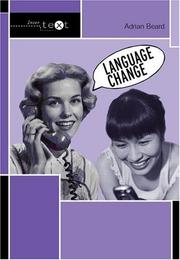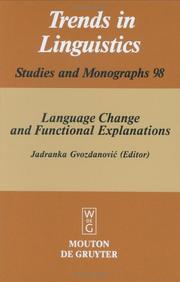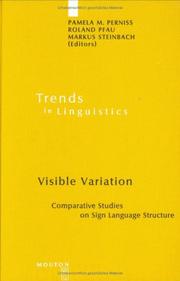| Listing 1 - 10 of 54 | << page >> |
Sort by
|
Book
ISBN: 9789027242679 9027242674 9027268002 9789027268006 Year: 2015 Volume: 79 Publisher: Amsterdam John Benjamins Publishing Company
Abstract | Keywords | Export | Availability | Bookmark
 Loading...
Loading...Choose an application
- Reference Manager
- EndNote
- RefWorks (Direct export to RefWorks)
Historical linguistics --- Grammar --- Dialectology --- Linguistic change --- Construction grammar --- Linguistic change. --- Construction grammar. --- Changement linguistique --- Grammaire de construction --- Changement linguistique. --- Grammaire de construction. --- Grammar, Comparative and general --- Change, Linguistic --- Language change --- Language and languages

ISBN: 0415320550 0415320569 1134360681 1134360673 0203354990 1280037326 020369435X 9780203694350 9786610037322 6610037329 9780415320559 9780415320566 9781134360673 9781134360680 9780203354995 9781280037320 Year: 2004 Publisher: London Routledge
Abstract | Keywords | Export | Availability | Bookmark
 Loading...
Loading...Choose an application
- Reference Manager
- EndNote
- RefWorks (Direct export to RefWorks)
Language Change, examines the way external factors have influenced and are influencing language change, focusing on how changing social contexts are reflected in language use.
Linguistic change. --- Taal --- Taalverandering. --- Evolutie. --- Historical linguistics --- Sociolinguistics --- Linguistic change --- Change, Linguistic --- Language change --- Language and languages --- Changement linguistique
Book
ISBN: 0253054257 Year: 1983 Publisher: Indiana University Press
Abstract | Keywords | Export | Availability | Bookmark
 Loading...
Loading...Choose an application
- Reference Manager
- EndNote
- RefWorks (Direct export to RefWorks)
The elusive study of language change deals with discernible realia, such as sounds or structured groups of sounds, or words with their intra- and interrelationships. But these empirial data are constantly changing, and even interpreting them may be influenced by new linguistic circumstances. Description of language change has the advantage of hard evidence, but uncovering the reasons behind a set of language data is not a secure task. Language Change investigates the many facets of human activity that bear on this complex field. It relies on the polar areas of phonology, with its immediate alliance to physiology and physics, and semantics, with its penetration into the meaning of the world at large. Irmengard Rauch and Gerald F. Carr have organized the volume in four sections—Contemporary Change, Historical Change, Linguists on Language Change, and Strata and Language Change—with almost half the chapters offering contemporary data.The distinguished contributors are Barbara Greim, Wayne Harbert, Henry and Renee KahaneI, Ilse Lehist, Winfred P. Lehmann, David Lightfoot, Yakov Malkiel, Raven McDavid Jr., Els Oksaar, Edgar Polome, Irmengard Rauch, and Frans VanCoetsem. Their range of topics reflects the kaleidoscopic essence of language change itself and will be of falue not only to linguists and semioticians but to historians, sociologists, philosophers, and anthropologists as well.
Aufsatzsammlung --- Sprachwandel --- Taalverandering. --- Linguistic change. --- Changement linguistique --- Congres. --- Change, Linguistic --- Language change --- Historical linguistics --- Language and languages --- Linguistics

ISBN: 3110139502 3110885174 9783110885170 9783110139501 Year: 1995 Volume: 81 Publisher: Berlin Mouton de Gruyter
Abstract | Keywords | Export | Availability | Bookmark
 Loading...
Loading...Choose an application
- Reference Manager
- EndNote
- RefWorks (Direct export to RefWorks)
Linguistic Change under Contact Conditions Trends in Linguistics. Studies and Monographs [TiLSM]
Languages in contact. --- Linguistic change. --- Historical linguistics --- Comparative linguistics --- Languages in contact --- Linguistic change --- Langues en contact --- Changement linguistique --- Change, Linguistic --- Language change --- Language and languages --- Areal linguistics

ISBN: 3110149133 1306275199 3110813750 9783110813753 9783110149135 Year: 1997 Volume: 98 Publisher: Berlin Mouton de Gruyter
Abstract | Keywords | Export | Availability | Bookmark
 Loading...
Loading...Choose an application
- Reference Manager
- EndNote
- RefWorks (Direct export to RefWorks)
No detailed description available for "Language Change and Functional Explanations".
Functionalism (Linguistics) --- Linguistic change --- Fonctionnalisme (Linguistique) --- Changement linguistique --- Congresses --- Congrès --- Historical linguistics --- Grammar --- Congresses. --- Language and languages --- Linguistic change - Congresses. --- Functionalism (Linguistics) - Congresses.


ISBN: 9783110198850 3110198851 9783110195781 311019578X 1282194593 9781282194595 9786612194597 6612194596 Year: 2008 Volume: 188 Publisher: Berlin Boston
Abstract | Keywords | Export | Availability | Bookmark
 Loading...
Loading...Choose an application
- Reference Manager
- EndNote
- RefWorks (Direct export to RefWorks)
It has been argued that properties of the visual-gestural modality impose a homogenizing effect on sign languages, leading to less structural variation in sign language structure as compared to spoken language structure. However, until recently, research on sign languages was limited to a number of (Western) sign languages. Before we can truly answer the question of whether modality effects do indeed cause less structural variation, it is necessary to investigate the similarities and differences that exist between sign languages in more detail and, especially, to include in this investigation less studied sign languages. The current research climate is testimony to a surge of interest in the study of a geographically more diverse range of sign languages. The volume reflects that climate and brings together work by scholars engaging in comparative sign linguistics research. The 11 articles discuss data from many different signed and spoken languages and cover a wide range of topics from different areas of grammar including phonology (word pictures), morphology (pronouns, negation, and auxiliaries), syntax (word order, interrogative clauses, auxiliaries, negation, and referential shift) and pragmatics (modal meaning and referential shift). In addition to this, the contributions address psycholinguistic issues, aspects of language change, and issues concerning data collection in sign languages, thereby providing methodological guidelines for further research. Although some papers use a specific theoretical framework for analyzing the data, the volume clearly focuses on empirical and descriptive aspects of sign language variation.
Sign language. --- Language and languages --- Psycholinguistics. --- Linguistic change. --- Langage par signes --- Variation (Linguistique) --- Psycholinguistique --- Changement linguistique --- Variation. --- linguistic typology. --- Linguistic change --- Psycholinguistics --- Sign language --- Variation
Book
ISBN: 9789027248381 9789027274809 9027248389 9027274800 1280497572 9786613592804 9781280497575 6613592803 Year: 2012 Publisher: Amsterdam Benjamins
Abstract | Keywords | Export | Availability | Bookmark
 Loading...
Loading...Choose an application
- Reference Manager
- EndNote
- RefWorks (Direct export to RefWorks)
The International Conference on Historical Linguistics has always been a forum that reflects the general state of the art in the field, and the 2009 edition, held in Nijmegen, The Netherlands, fully allows the conclusion that the field has been thriving over the years. The studies presented in this volume are an expression of ongoing theoretical discussions as well as new analytical approaches to the study of issues concerning language change. Taken together, they reflect some of the current challenges in the field, as well as the opportunities offered by judicious use of theoretical models an
Historical linguistics --- Linguistic change --- Linguistique historique --- Changement linguistique --- Congresses. --- Congresses --- Congrès --- Historical linguistics -- Congresses. --- Linguistics -- History. --- Linguistics. --- Historical linguistics. --- Languages & Literatures --- Philology & Linguistics --- Congrès --- E-books --- Conferences - Meetings
Book
ISBN: 9780199573745 0199573743 0191648493 1299939732 0191745243 9780191648496 9780191745249 Year: 2013 Publisher: Oxford Oxford University Press
Abstract | Keywords | Export | Availability | Bookmark
 Loading...
Loading...Choose an application
- Reference Manager
- EndNote
- RefWorks (Direct export to RefWorks)
Explanations for sound change have traditionally focused on identifying the inception of change, that is, the identification of perturbations of the speech signal, conditioned by physiological constraints on articulatory and/or auditory mechanisms, which affect the way speech sounds are analyzed by the listener. While this emphasis on identifying the nature of intrinsic variation in speech has provided important insights into the origins of widely attested cross-linguistic sound changes, the nature of phonologization - the transition from intrinsic phonetic variation to extrinsic phonological encoding - remains largely unexplored. This volume showcases the current state of the art in phonologization research, bringing together work by leading scholars in sound change research from different disciplinary and scholarly traditions. The authors investigate the progression of sound change from the perspectives of speech perception, speech production, phonology, sociolinguistics, language acquisition, psycholinguistics, computer science, statistics, and social and cognitive psychology. The book highlights the fruitfulness of collaborative efforts among phonologists and specialists from neighbouring disciplines in seeking unified theoretical explanations for the origins of sound patterns in language, as well as improved syntheses of synchronic and diachronic phonology.
Phonetics --- Phonologie --- Changement linguistique --- Grammar, Comparative and general --- Linguistic change. --- Phonology. --- Klankverschuiving. --- Phonologie. --- Change, Linguistic --- Language change --- Historical linguistics --- Language and languages --- Phonology --- Linguistics --- Philology --- Grammar, Comparative and general Phonology
Book
ISBN: 9783110251340 9783110251357 3110251353 3110251345 128288526X 9786612885266 3112191919 Year: 2010 Volume: 537 Publisher: Berlin De Gruyter
Abstract | Keywords | Export | Availability | Bookmark
 Loading...
Loading...Choose an application
- Reference Manager
- EndNote
- RefWorks (Direct export to RefWorks)
Dieses Buch widmet sich der diachronen Entwicklung von Valenzalternationen, d.h. der Verwendung eines Verbs in verschiedenen syntaktischen Konstruktionen. Wie entstehen neue Mittel des formalen Ausdrucks der Alternationen, wie breiten sich diese neuen Mittel aus und welche sind die Auswirkungen der Entstehung und Ausbreitung auf bereits bestehende Mittel? Diese Fragen werden im vorliegenden Buch anhand der Entwicklung der französischen Kausativ-Antikausativ-Alternation behandelt.
French language --- Grammar --- Causative. --- Reflexives. --- Verb. --- Grammar, Historical. --- Langue d'oïl --- Romance languages --- Changement linguistique --- Grammaire de dépendance --- Causatif (linguistique) --- Constructions réfléchies (linguistique) --- Linguistics. --- Romance Studies. --- Semantics. --- Syntax. --- Valency. --- Grammaire de dépendance --- Constructions réfléchies (linguistique)

ISBN: 0195066073 9780195066074 1280605553 0195362101 9780195362107 9781280605550 0197721427 Year: 1996 Publisher: S.l. Oxford university press
Abstract | Keywords | Export | Availability | Bookmark
 Loading...
Loading...Choose an application
- Reference Manager
- EndNote
- RefWorks (Direct export to RefWorks)
This volume draws together previously unpublished papers by linguists engaged in historical reconstruction. The main subject of the work is regularity and irregularity in the comparative method. A number of language families are represented.
Linguistic change --- Comparative linguistics --- Historical linguistics --- Change, Linguistic --- Language change --- Language and languages --- Comparative philology --- Philology, Comparative --- Linguistique comparée --- Changement linguistique --- Comparative linguistics. --- Linguistic change. --- Historische taalwetenschap. --- Taalverandering. --- Regelmaat. --- Methodologie. --- Gesetzmä�igkeit. --- Kontrastive Linguistik. --- Sprachwandel. --- Vergleichende Sprachwissenschaft. --- Historische Sprachwissenschaft.
| Listing 1 - 10 of 54 | << page >> |
Sort by
|

 Search
Search Feedback
Feedback About UniCat
About UniCat  Help
Help News
News